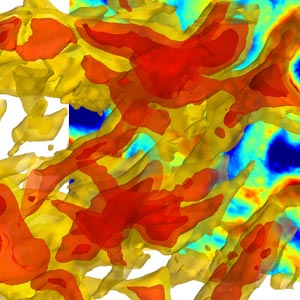KTH enters the petaflop era with new supercomputer

Fusion research simulated with supercomputers. (Photo: KTH PDC)
Sweden's KTH Royal Institute of Technology is due to begin using the fastest academic supercomputer of any university in Scandinavia. A Cray XC30 with 1,676 nodes and a memory of 104.7 terabytes will be installed at KTH’s PDC Center for High Performance Computing.
Access to the updated computational capacity will be through the Swedish National Infrastructure for Computing, SNIC.
Some of the uses for the computer will include fluid dynamics, climate modelling, plasma physics, neuroscience, materials science and molecular simulation.
The new system will operate at a peak performance of nearly 2 petaflops, which will make it six times faster than the university’s current supercomputer, Lindgren.
A single petaflop is equal to one thousand million (1015) floating-point operations per second. And like Lindgren, the new computer will be named after yet another renowned Swedish children’s author – in this case, Elsa Beskow.
The investment in KTH’s new supercomputer – including supporting systems, storage and running costs – has a budget of 170 million SEK divided over four years.
The funding comes primarily from SNIC, KTH and industry. After the installation of the system in October, there will be a period of preliminary testing, with the system expected to be in full production on January 1, 2015.
The supercomputer will be physically located at KTH’s supercomputer centre PDC.
Media Contact
All latest news from the category: Physics and Astronomy
This area deals with the fundamental laws and building blocks of nature and how they interact, the properties and the behavior of matter, and research into space and time and their structures.
innovations-report provides in-depth reports and articles on subjects such as astrophysics, laser technologies, nuclear, quantum, particle and solid-state physics, nanotechnologies, planetary research and findings (Mars, Venus) and developments related to the Hubble Telescope.
Newest articles

Properties of new materials for microchips
… can now be measured well. Reseachers of Delft University of Technology demonstrated measuring performance properties of ultrathin silicon membranes. Making ever smaller and more powerful chips requires new ultrathin…

Floating solar’s potential
… to support sustainable development by addressing climate, water, and energy goals holistically. A new study published this week in Nature Energy raises the potential for floating solar photovoltaics (FPV)…

Skyrmions move at record speeds
… a step towards the computing of the future. An international research team led by scientists from the CNRS1 has discovered that the magnetic nanobubbles2 known as skyrmions can be…





















